How to Properly Store Flour [Short and Long Term Solutions]
This post may contain affiliate links.
Ever wondered how to properly store your flour - both in the short term and the long term?
No matter what your issues are, fresh flour is certain to help you make the freshest and most delicious sourdough bread.
After taking the time to select and purchase the right flour for your bread and sourdough, the last thing you want is for it to expire or go bad whilst waiting to to be turned into delicious bread!
In this article, I am going to tell you all about flour storage. How you can keep your flour for the long term or for the short term.
Whether you are trying to find a long-term storage solution for white flour or you want to prolong the life of any other type of flour. In this article, we are going to discuss this in much more detail.
Why Is Flour Storage Important?
Flour storage is important because you want to protect the flour you buy from moisture, heat, odors, mold, insects and UV light. These are the main causes of flour going bad.
No matter how often you bake or how frequently you bake, you will want to use fresh flour every time. Given that you probably don't want to buy a new bag of flour every time you bake, storing flour properly is very important. The right flour storage can help you to bake sourdough on a lower budget.
If you take the right precautions you can keep your flour fresh and ensure a fantastic end result for your baked goods.
If you are using refined flour like all-purpose or bread flours, for example, it would be a good idea to store it in an airtight container.
You could use a glass, plastic storage container, or even a Ziploc bag if you do not have a proper container.
- Long Term – You may not use flour as frequently as others and because of this you need a way to store your flour for longer. I have found that if you store it in a freezer it can extend the shelf-life of your flour for a year. While flour that is stored in a dark, dry, and cool place will keep the shelf-life for a year, freezing flour can make it last twice that. Freezing your flour can double the amount of time your flour can be stored. I recommend doing this if you want to improve your long-term storage of flour.
- Short Term – If you are planning to store your flour properly for a short amount of time, you should use an airtight container and store your flour in a place that is dark, cool, and dry. By doing this you will be able to keep your flour fresh for the shelf-life of the product. So, storing your flour like this will keep it fresh for about one year. You could use glass jars, plastic containers, or even a Ziploc bag.
How Should I Store My Flour?
The best ways to store flour properly are:
- Plastic Containers
- Glass Jars
- Large Plastic Buckets
- Mylar Bags
There are many things to consider when considering how to store flour properly.
You need to consider the type of flour you are storing, as well as the length of time you will be storing it for.
Some of the things you will need to consider are material, shape and size of the container, as well as space.
- Material – There are a wide variety of options for you to pick from for your container. Acrylic? Glass? Plastic? The best option in my opinion is plastic because it is easiest to freeze and does not shatter like some types of glass. In addition to that, plastic containers are often clear, so you can easily see how much flour you have left. So, whether you use plastic containers or glass jars you need something that suits you.
- Shape & Size of the Container – The container you pick must be suitable for the storage space you have available. So, make sure you have a container that is easy to store and fits in the space you have available. I recommend something that is stackable. But this depends on how much flour you will be storing and whether it is in your pantry or in your freezer.
- Space – Of course, it is vital that you understand how much space you have available. Is your pantry space limited? Maybe you only have one spot on a shelf, or maybe you have a bigger spot on the floor you can use. Regardless of where you have space, make sure that the container you pick is suitable and can easily be stored there.
- Lid – The container you chose must have a lid that closes completely and is airtight. No matter what kind of lid you pick, make sure that it closes properly.
My final tip for this section is to consider Ziploc bags or even vacuum-sealed bags. They are fantastic to use if you have small annoying spaces to use in your freezer or even in the pantry.
Just make sure that there is no air in the bag, otherwise, your flour will not last as long as it ought to. It can also be a good idea to double bag the ziploc bags. This ensures nothing can get into the bag.
Here is a table that shows the pros and cons of different types of flour storage:
| TYPE OF CONTAINER | LENGTH OF STORAGE | WHERE CAN IT GO? | BENEFITS | WATCH OUT FOR |
|---|---|---|---|---|
| PLASTIC CONTAINTER | LONG TERM | FREEZER OR PANTRY | RANGE OF SIZES, DURABLE | UV LIGHT, FAULTY SEALS |
| ZIPLOC BAG | SHORT TERM | FREEZER OR PANTRY | GOOD FOR SMALL SPACES | UV LIGHT, RODENTS, BUGS, MOISTURE |
| FOOD SAFE BUCKET | LONG TERM | PANTRY | GOOD FOR LARGE QUANTITIES, BULK BUYS | FAULTY SEALS |
| VACUUM SEALED POUCH | LONG TERM | FREEZER OR PANTRY | GOOD FOR SMALL SPACES | FAULTY SEALS |
| MYLAR BAG | LONG TERM | FREEZER OR PANTRY | ||
| GLASS JAR | SHORT TERM | PANTRY | MINIMAL COST | BREAKAGES, SHATTERING |
Plastic Containers
Plastic containers are the easiest and most cost effective way to store flour. They are available in a wide range of sizes and styles and there is more than likely something that will suit your budget.
You can easily store up to 2kg of flour in a 5L plastic container. They are also stackable which ensures they are easy to store in your pantry and use your space effectively.
Plastic containers can be better than glass because it eliminates the risk of shattering in the freezer or from being dropped. I find plastic is a good way to store flour around kids because I don't have to stress about them breaking the jar.
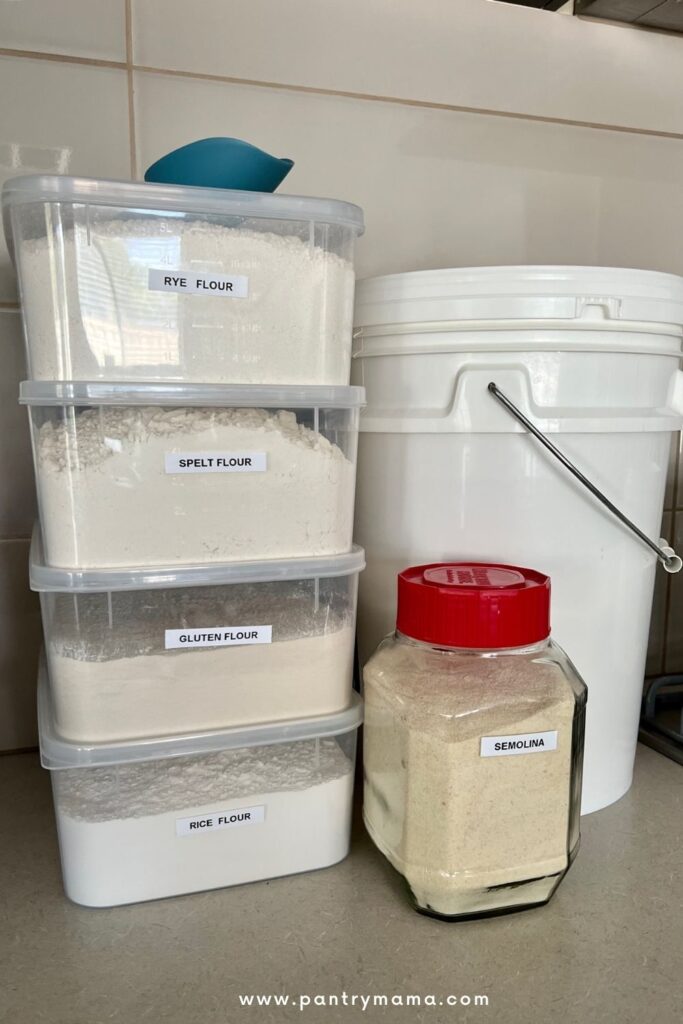
Glass Jars
Glass jars can be an effective way to store smaller quantities of flour. They are a good alternative to plastic if you are concerned about storing food in plastic.
You can use recycled coffee jars or other large jars, but it can be difficult to find glass jars that will hold more than 1kg of flour.
I find glass jars are handy for smaller, more specialised flours like semolina or even the rice flour I sprinkle into my bannetons.
I try to use recycled jars for this purpose.
I also use small glass jars if I mill some wheat berries. Freshly milled flour contains a lot of moisture so shouldn't be stored for long periods. If I mill fresh wheat berries for my sourdough starter, I place the flour in a jar for a few days.
Large Plastic Buckets
Large plastic buckets with lids can be very effective to store flour for longer periods.
Food safe, BPA free buckets that hold around 20L are perfect. You do need to ensure that they have a tight fitting lid, particularly if you are wanting to store the flour long term.
These buckets are generally made from solid plastic that you cannot see through which will protect the flour from UV light.
I can fit up to 15kg of flour into a 20L food bucket. I store my bread flour in a food bucket on the floor of my pantry.
Large, food safe buckets are also a great way to store wheat berries if you are milling flour fresh when you need it.
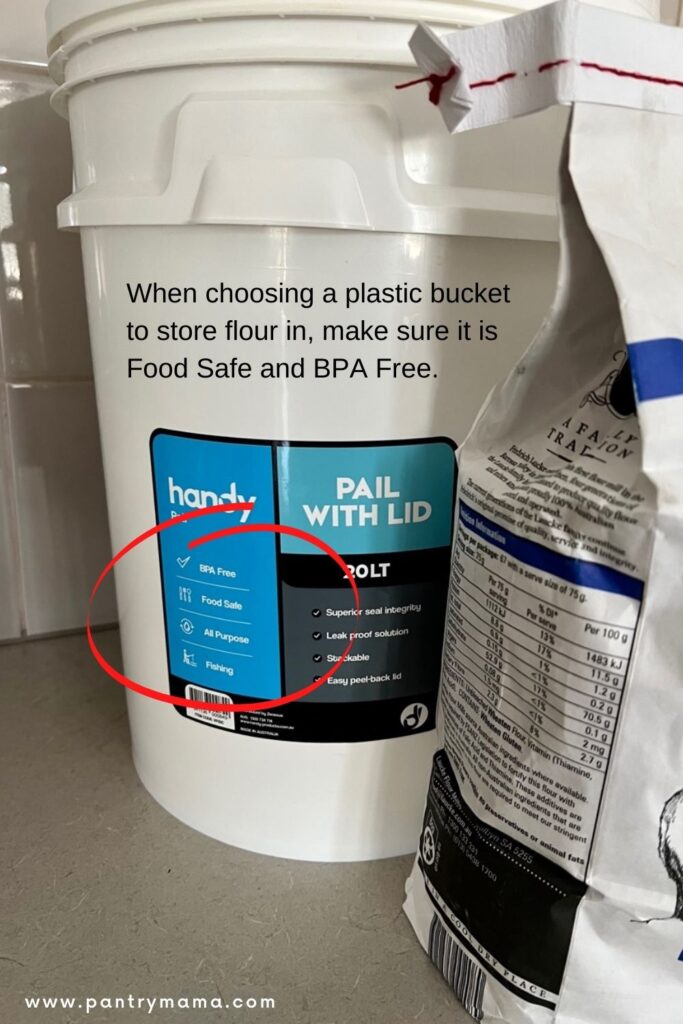
Mylar Bags
Mylar bags are food safe bags created from layers of laminated food grade plastic and aluminium. They come in a variety of sizes from tiny right up to 5 gallon!
5 gallon mylar bags are an effective way to store flour long term.
They can be good for long term flour storage because they can be stacked and take up less room the a large bucket. They also completely eliminate light and oxygen, creating a hostile environment which prevents insect eggs from hatching.
Placing an oxygen absorber in your mylar bags is a good idea.
Remember To Label Your Flour!
This might seem really obvious, but you know when you're in a rush and you just dump a bag of flour into your container thinking you'll remember what it is.
A few weeks later you go to find it and now you can't work out whether it's rye or whole wheat? We've all been there!
I invested in a simple label maker so that I can label my flours easily. I like being able to create the labels when I need them, rather than buy them pre printed because I can use the containers over and over.
I get my kids to help me label the containers - extra spelling practice!
Can You Freeze Flour?
Yes you can freeze flour. There are actually many advantages to freezing flour.
Freezing flour can:
- Kill any insect eggs present in the flour when you purchase it
- Keep flour fresh in humid and tropical environments
- Protect flour from UV light
- Stop flour from absorbing odors in your pantry.
To successfully store flour in the freezer, you need to ensure that it's taken out of the paper sack and placed into a sealed plastic container. Avoid glass as it can shatter in the freezer. You could also use a mylar bag for this.
Ziploc bags work for smaller amounts of flour too.
If you are wanting to store large amounts of flour in your freezer, you may need to consider purchasing a large, chest type freezer for this purpose.
How To Store Flour in a Humid Environment
If you live in a tropical or particularly humid environment, it can be a good idea to store your flour in the fridge or freezer.
Once the flour has been frozen for 24 hours (and any insect eggs have been dealt with) you can then store it in the fridge.
While the fridge is a moist environment, storing the flour in a sealed plastic container in the fridge will stop the flour from going moldy in the humidity.
Moldy flour can cause many problems, including causing your sourdough starter to go moldy.
Special Considerations for Storage of Whole Grain Flours
Whole grains tend to spoil more quickly because they contain a relatively high concentration of oils (the bran and the germ). This is even more true if you are milling your own grains.
In fact, if you are milling your own grains, it's better to store the grains whole and only mill them as you need them. Once ground, they will spoil very quickly.
If you want to keep the whole grains fresh for longer periods of time, store them in an airtight bucket. Make sure they are in a cool, dark area away from any sources of heat and light.
Below you can see some common whole grain flours and the shelf life based on how they have been stored:
- Barley – This whole grain flour can be stored for up to 3 months in a pantry and 6 months in a freezer before going off.
- Rye – This whole grain flour can be stored for up to 6 months in a pantry and 12 months in a freezer before going off.
- Spelt - This whole grain can be stored for up to four months in a pantry and six months in a freezer before going off.
- Whole Wheat – This whole grain flour can be stored for up to 3 months in a pantry and 12 months in a freezer before going off.
- Millet – This whole grain can be stored for up to two months in the pantry and six months in a freezer before going off.
- Oat – This whole grain can be stored for up to two months in the pantry and six months in a freezer before going off.
How Do You Know If Flour Has Gone Bad?
If your flour has spoiled you will know all about it. While it is normally relatively odorless when it has gone rancid flour on the other hand will have a kind of musty or sour smell.
It could also be discolored. If your white flour is any other color than white, chances are it's gone bad.
You should also check the best before or use by date of your flour. The normal shelf life of flour is around 1 year - but this will decrease if it's a less processed flour like whole wheat or brown rice for example.
Another way you can tell your flour has gone bad is the presence of flour beetles or weevils. Weevils leave little web like threads around the tops of your containers.
Moldy Flour
You have decided to bake a fresh and delicious loaf of bread, you gather your ingredients, and finally, you go to grab the flour from the pantry.
But, when you open it there is a strong musty smell and if you look closely the flour is discolored. Or, if you are really unlucky you will be able to see the mold growing on the flour.
There is sadly not much you can do about this issue, and you will just need to throw it in the trash. When moldy flour is ingested, it can be extremely dangerous.
On the other hand, if it isn't a dangerous kind of mold (such as black mold), then it will most likely have an awful taste. Toxic mold produces dangerous toxins called mycotoxins.
Some toxins can cause some pretty bad side effects, some of them are short-term and others are long-term. A few of these side effects include vomiting or diarrhea. The long-term side effects from ingesting dangerous mold can be that your immune system will be compromised or even worse it can cause some kinds of cancer.
Because mold can be such a dangerous thing to consume it is extremely important that you store your flour properly. DO NOT leave it somewhere moisture can seep in.
So, before you use your flour check that there are no musty smells and if there is any discoloration or old on top you should immediately toss it.
It’s critical that your flour be kept in a dry place. Make sure to smell your flour and check that there are not any rank odors, and if you suspect that there might be even a bit of mold it isn't worth trying to save it. You will be much better off throwing it away.
Flour Bugs
Flour bugs are often found in flour and in the paper bags which hold the flour itself, though they aren’t limited to either of these. They are very small brown bugs that feed on the flour and also lay their eggs in it.
You may have seen weevils in other kinds of grain like maize.
If it is not a weevil you are probably seeing some kind of beetle in your flour. But, weevils and flour bugs are the same things, and they can be a scourge on your flour or other grains if you are not careful.
These bugs can easily infiltrate your flour through various stages in the production of flour. The following are the most common
- Grocery Store
- The Mill
- Your Own Home
Female weevils lay their eggs in the flour or sometimes within the bag lining. The eggs are quite small, so you won't notice them until they start moving, and by then it is probably too late.
At this point, you have limited options to try to save your flour from being completely over-run by weevils. The first thing you can do is find a very fine sieve and then sift through all of your flour in the hopes of catching all the weevils and their eggs.
After this point, you should freeze the flour so that none of the eggs survive and are not able to hatch out more irritating insects. Before we move on I have a fun little nugget of wisdom for you guys.
If you are a lover of whole grains you might be pleased to find out that weevils do not eat this form of grain. In fact, they can not eat them. A weevil will only eat the fine dust or any small bits of grain that has been broken down.
But not the grain itself. With that out of the way, let us look at what you can do to prevent an infestation of weevils.
Things You Can Do To Prevent A Flour Bug Infestation
The best thing you can do to prevent a bug or weevil infestation in your pantry is to freeze the flour for 24 hours when you first get it home. This is said to kill the bugs and the eggs.
Once it's been frozen for 24 hours, transfer it to air tight container and store in your pantry. By doing this you will kill the eggs and prevent them from hatching.
What Can I Do With Flour Which Has Gone Bad?
While you don't want to bake with spoiled flour, you can use it for other things (so long as it's not moldy).
So if the flour has reached the end of its life, here are a few things that you can do with it.
Play-Doh – If you want to make clay ornaments or a fun activity for your children, Play-Doh is a fantastic thing you can make from flour which has gone off. You can even bake it for about 30 minutes and paint your creations afterward if you like. So, find a recipe for Play-Doh and make something fun.
A barrier for Ants – If you have an issue with ants you can use flour as a way to make sure they do not go somewhere they should not be. Simply sprinkle a line of flour in an area where the ants are coming in, and they will not cross. A simple ant-free home.
Papier-mâché – You can use flour to make glue for Papier-mâché. All you need to do is add an equal amount of water and flour, and you will be ready to get creative.
Compost – If you have a composter you can toss the rancid flour into it and think nothing more of it.
Gardening – You can use rancid flour to keep grasshoppers and other insects from eating the plants you have been working so hard to keep alive. All you have to do is spread the flour over your plants.
What Should You Avoid When You are Storing Flour?
There are certain things that will prevent you from storing flour long term. Exposing flour to these things will shorten the lifespan of your flour.
- Light – You might be lucky enough to have a pantry that is open to direct sunlight. While this looks nice it is not ideal for storing flour. You should probably consider a container that is not see-through. The best you can hope for is to have a clear strip to allow you to see how much flour you have left. Flour needs to stay in a cool place. So, you should ideally store it in a refrigerator or a freezer for the best results.
- Heat – You need to make sure that you do not store your flour anywhere that is too warm. Keep it at a cooler temperature. As I have said, the temperature should be between 68 and 77 degrees Fahrenheit. if your home climate is too warm you should consider freezing or refrigerating your flour.
- Moisture – You need to keep the area you are storing your flour, container and room alike, needs to be dry. If you have a humid or wet area when you open your flour container that moisture can get in, and you will have moldy flour on your hands.
- Air – Keep any excess air out of your container. This goes for freezing and storing your flour. So, if you are using a Ziploc bag make sure there is no extra air in the bag and the same goes for any container. Rather move your flour to a smaller container than leave it with too much airspace.
- Transfer – Always transfer your flour. Do not keep it in the bag you bought it in. This is because sometimes that bag can have flour bug eggs in it and of course, your paper flour bags are not airtight. This will make it much easier for your flour to go bad.
Frequently Asked Questions
Yes you can store flour in ziploc bags. They are food safe and available in a range of sizes so you are sure to find the right size. They are not great for long term flour storage because they can be chewed through by pests or infiltrated by bugs. They are also exposing the flour to light which is not good for long term flour storage. Ziploc bags are fine for short term flour storage.
Yes flour can absorb smell from the air, as well as the container in which it is stored. It is for this reason you should always store flour in an air tight container that is free from smell. BPA free, food safe plastic or glass is a good option to protect flour from absorbing odors.
You can store flour in the fridge as long as it's in an airtight container that keeps out moisture. Storing flour in the fridge can be helpful in humid and tropical environments where it may go moldy if stored in the pantry.
Yes you can use flour after its expiry date. This date is just a "best before" date and does not mean the flour is necessarily "bad". As long as it smells and looks ok, it will be safe to consume. The manufacturer puts this date on as a guide. They cannot guarantee the flour after this date, but it is generally fine if it has been store correctly.
Yes you can store flour for 10 years or more. You will need to ensure that it is completely sealed (mylar bags are best) and stored in a cool, dark place away from heat, light and bugs. Placing a moisture absorber in the bag can help to prolong the storage time.
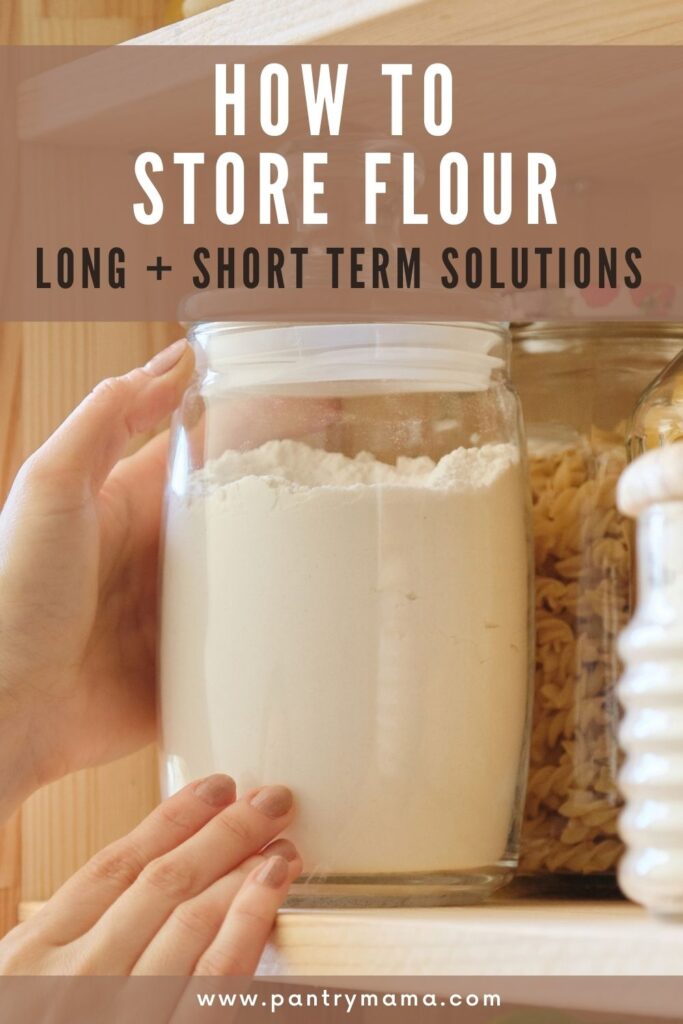
Want More Info?
If you are looking for even more info on flour and sourdough, you'll love these articles:
- Best flour for making sourdough bread
- Give Your Sourdough Starter a Boost
- Are Sourdough Discard Recipes Really Healthy?


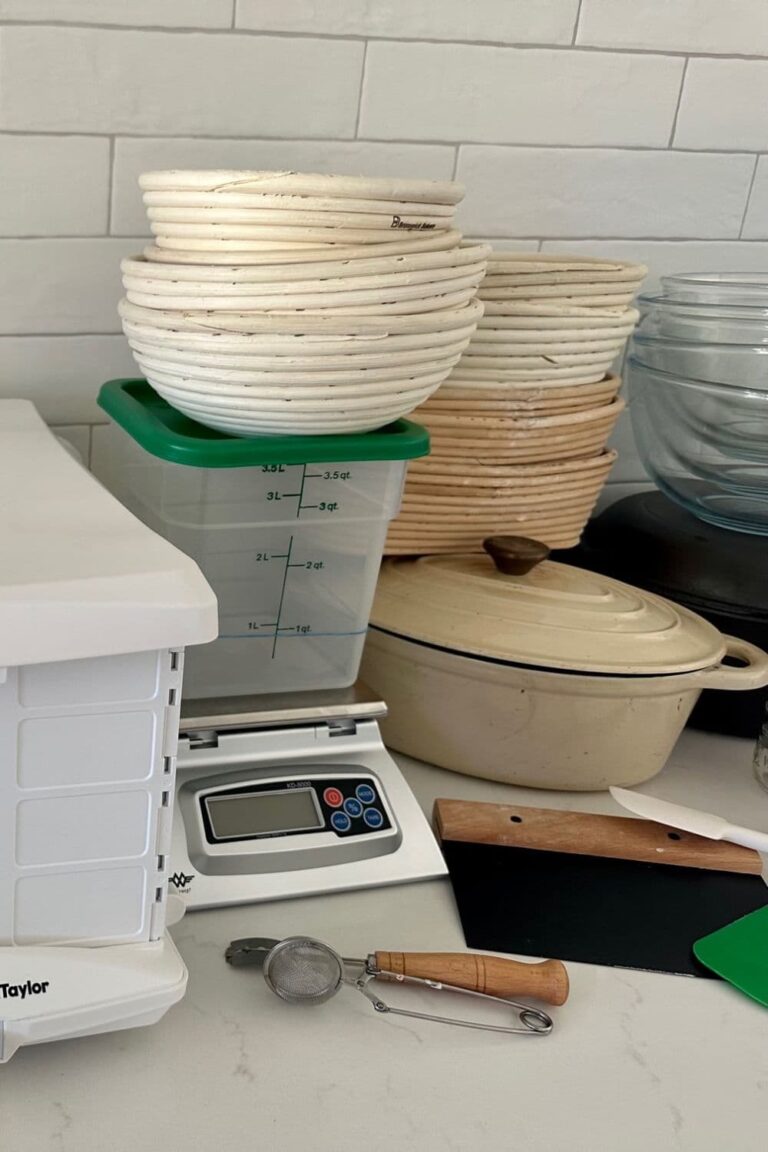


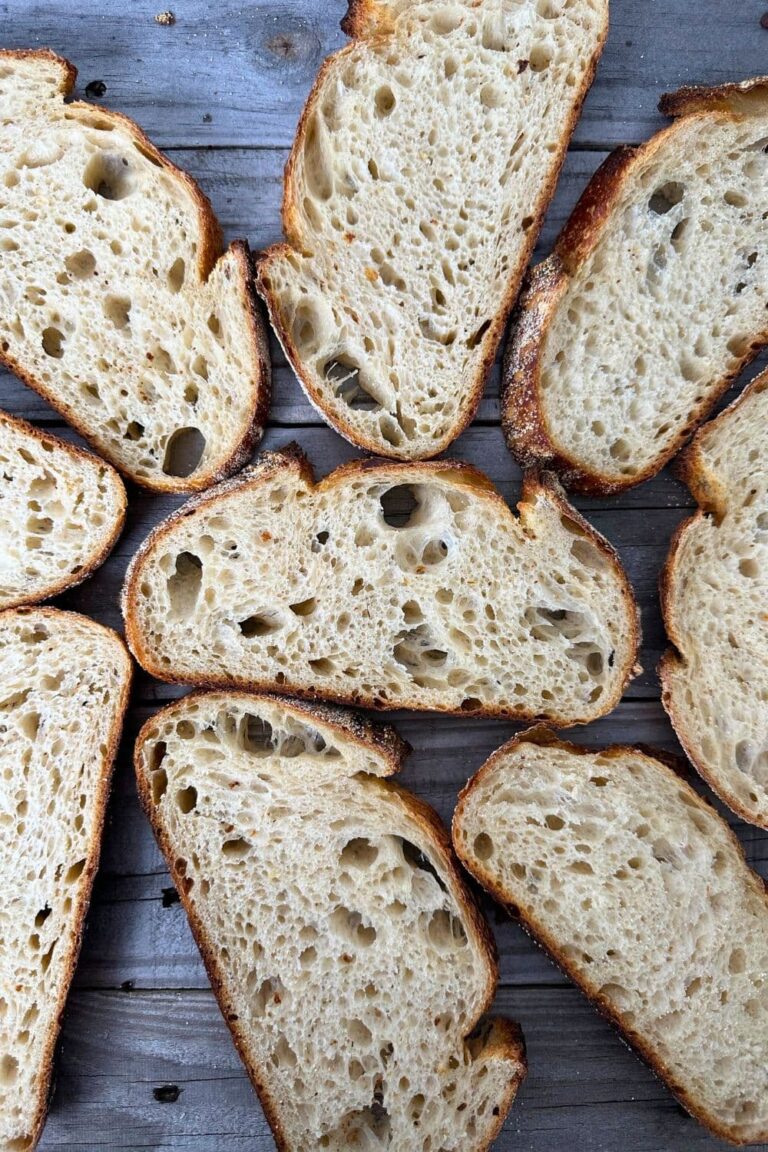

Can flour be vacuumed bagged in the bag it came in?
Thanks for all these wonderful posts and recipes. Was wondering if your book gives all the information on flours and starters. Also, I am very interested in using discard on my house plants but was unable to print out the information. Is included in your book as well?
I've had good luck getting large buckets with lids from the bakery department at my local grocery store. Usually the buckets have held icing, so they need serious cleaning, but the grocery throws the buckets away, unless someone asks for them.
I have about a half kg of White wings organic flour (10.9g protein) in its original packet bought from store. Was going to throw it out but after reading this. The flour is white, has no bad smells and looks good. The use by date is 2010, that's 12 years ago. I am going to test this by making some bread. If this turns out OK? Would that debunk the myth of flour going off after 12 months? Has anyone ever shown evedence of rancid unusable flower kept in cupboard after 12 months, let alone 12 years?